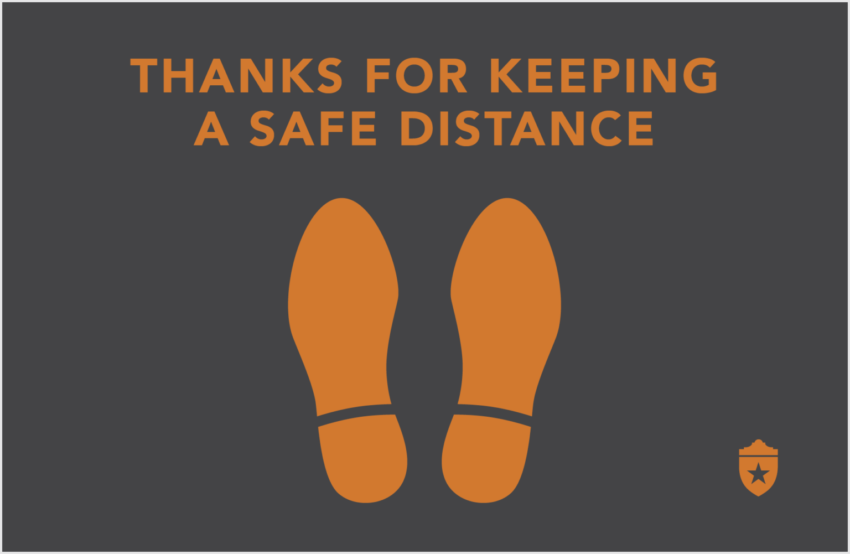As the Fourth of July approaches, we remember the principles of freedom upon which our country was founded. Freedom allows choices. As the coronavirus surges in Texas, UT Health San Antonio urges Texans to lower their risk. Choose the right behaviors. We can stop the spread, and below, we describe a way to do it.
* * *
Some people need their space. Others are physically affectionate.
Some occupations require clients and providers to be near each other. Other jobs can be performed by a person working alone.
Some activities take place indoors. Others occur outdoors or can be moved outside.
These are elements of “contact intensity” – the science of social distancing, said Barbara Taylor, MD, MS, associate professor of medicine at UT Health San Antonio’s Long School of Medicine. Dr. Taylor also serves as assistant dean for the medical school’s MD/MPH program.
Observing 6-foot social distancing when out in public is one of the safe behaviors advocated in UT Health San Antonio’s “We Can Stop the Spread” public education initiative. Know who is on your “quaran-team,” the small number of people with whom you come into contact with regularly, like your family, and stay 6 feet away from everyone else. This means having a conversation with those you are close with about risk and avoiding indoor gatherings with others.
“The way individuals behave either reduces their risk or increases it,” Dr. Taylor said. “The challenge in a pandemic is to minimize risk for everyone in many different contexts, while ensuring we continue the activities that we all must do, such as working, going to school, exercising and shopping.”
Contact intensity is a key tenet of the local COVID-19 Health Transition Team’s plan for reopening San Antonio and Bexar County after spring stay-at-home orders. Dr. Taylor and other UT Health San Antonio faculty members served on the team.
Contact intensity asks several questions:
- Are people close to one another – less than 6 feet – or are they further away?
- How many people are in a setting at the same time?
- How easy is it to modify an activity or a setting to reduce risk?
“These facets of contact intensity are really variable,” Dr. Taylor said. “You can’t say, for example, that all bars have the same amount of risk. Some bars are outside, and we know outdoors hugely reduces risk.”
A study of COVID-19 case reports in 320 Chinese cities, conducted in January and February, found that all confirmed outbreaks of three or more cases in hundreds of cities occurred indoors.1
The coronavirus is spread by respiratory droplets that travel up to 6 feet, and there is evidence that masks worn over the mouth and nose reduce risk of coronavirus transmission. Standing or sitting 6 feet away means the droplets may not reach you.
The number of people in a setting also matters.
“Let’s say everyone at a family reunion is 6 feet apart and is masked, and 50 people are there,” Dr. Taylor said. “Is it as safe as a family reunion with the same conditions but only 15 people are there? No, it’s not. There is more potential for one of the attendees at the larger reunion to be walking around with the infection. It’s math.”
The third factor of contact intensity, environmental modification, can be accomplished in various ways. Placing hand sanitizer at the front door for use by visitors is a simple addition. Many large organizations, including UT Health San Antonio, check temperatures and ask screening questions at building entry points.
Stores have made a visual modification to their environments, placing social distancing stickers on the floor indicating where to stand to be 6 feet away from the next customer in line.
“These things take away some of the risk, but they don’t take away the risk of asymptomatic spread,” Dr. Taylor said. “So, there is no scenario that is no risk, once it’s not just you by yourself in a room.”
Duration of contact also matters. How long is a person in proximity with another? Are they talking? Is one coughing? The nature of what is occurring also matters.
A South Korea nightclub outbreak early in the pandemic showed the risk of being indoors in a loud setting where people were straining to hear each other talk.
Social distancing is a personal choice, ultimately, and each decision affects an individual’s contact intensity. As millions of people make these decisions every day, complying in varying degrees to what is best for themselves and others, the risk of infection is ever present. We don’t know who is asymptomatic positive.
“It’s up to you and me to mitigate risk,” Dr. Taylor said. “If you really want to lower your risk, then you need to stay 6 feet away from others, wash your hands, wear a mask in public, and do all the things we’ve been recommending all along.”
Sources:
1 https://www.medrxiv.org/content/10.1101/2020.04.04.20053058v1


